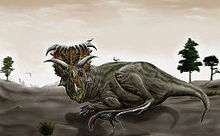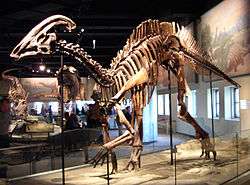Kaiparowits Formation
| Kaiparowits Formation Stratigraphic range: Upper Cretaceous,[1] 76.1–74 Ma | |
|---|---|
| Type | Geological formation |
| Thickness | 790 m (2,600 ft) |
| Lithology | |
| Primary | mudstone, sandstone |
| Location | |
| Coordinates | 37°24′0″N 111°41′0″W / 37.40000°N 111.68333°W |
| Region |
|
| Country |
|
The Kaiparowits Formation is a sedimentary rock formation found in the Kaiparowits Plateau in Grand Staircase-Escalante National Monument, in the southern part of Utah in the western United States. It is over 2800 feet (850 m) thick, and is Campanian in age. This Upper Cretaceous formation was formed from alluvial floodplains of large rivers in coastal southern Laramidia; sandstone beds are the deposit of rivers, and mudstone beds represent floodplain deposits. It is fossiliferous, with most specimens from the lower half of the formation, but exploration is only comparatively recent, with most work being done since 1982. It has been estimated that less than 10% of the Kaiparowits formation has been explored for fossils. Most fieldwork has been conducted by The Natural History Museum of Utah.
Habitat
The Kaiparowits Formation is a muddy bed that was deposited between about 76.1 to 74.0 million years ago,[2] in the area where the Grand Staircase-Escalante National Monument of Utah is today. It is extremely fossil rich, with thousands of plants and animal fossils being preserved in amongst its sand- and mud-stone deposits. Based on plants remains including multiple vines, leaves, and branches, It was assumed by paleontologists Scott Sampson and his colleagues that Utah in the Campanian was a dense jungle bordering the Western Interior Seaway. The jungle theory would also support why almost all the animals in the Kaiparowits Formation were new species, and why the deposits were so plentiful. Without the need for herbivores to migrate to find food, and theropods to migrate after herbivores, a whole ecosystem could evolve secluded from interbreeding. The theory also supported why the dinosaurs adorned such features like the 15 horns of Kosmoceratops, they were for sexual selection.[1]
Paleofauna

Animals present include chondrichthyans (sharks and rays), gars, bowfin, sturgeons, frogs, salamanders, turtles, lizards, crocodilians (including Deinosuchus),[3] coelurosaurian theropods such as dromaeosaurids, troodontids, and Ornithomimus velox, armored dinosaurs, the duckbill Parasaurolophus cyrtocristatus, and a variety of early mammals including multituberculates, marsupials, and insectivorans.[4] Recent finds include large specimens of the duckbill Gryposaurus,[5] including the new species G. monumentensis,[5] and the first described remains of the oviraptorosaurian Hagryphus giganteus.[6]
Trace fossils are also known from the Kaiparowits, including an excellently preserved hadrosaur skin impression known from a recent analysis by Herrero and Farke.[7]
Turtles
Color key
|
Notes Uncertain or tentative taxa are in small text; |
| Turtles reported from the Kaiparowits Formation | ||||||
|---|---|---|---|---|---|---|
| Genus | Species | Location | Stratigraphic position | Material | Notes | Images |
|
Boremys[8] |
B. grandis[8] |
A baenid |
||||
|
A. goldeni |
A baenid, notable for its atypical nasal structure. | |||||
|
D. nodosoa |
middle unit of the upper Kaiparowits Formation |
A baenid | ||||
|
Neurankylus[9] |
Two species[9] |
A baenid | ||||
|
Thescelus[9] |
int.[9] |
A baenid | ||||
|
C. victa [10] |
||||||
|
C. victa[10] |
||||||
|
indet., possibly several species[8] |
A adocid | |||||
|
B. nobilis[10] |
A possible member of Nanhsiungchelyidae. By far the largest native turtle at about 78 centimeters in length. | |||||
|
Helopanoplia[8] |
indt.[8] |
|||||
Ornithischians
Color key
|
Notes Uncertain or tentative taxa are in small text; |
| Ornithischians reported from the Kaiparowits Formation | ||||||
|---|---|---|---|---|---|---|
| Genus | Species | Location | Stratigraphic position | Material | Notes | Images |
|
G. monumentensis[11] |
 Undescribed ornithopod | |||||
|
K. richardsoni |
||||||
|
N. titusi |
middle unit of the upper Kaiparowits Formation |
A centrosaurine ceratopsid | ||||
|
P. cyrtocristatus[14] |
A parasaurolophin lambeosaurine hadrosaur | |||||
|
U. gettyi |
A chasmosaurine ceratopsid | |||||
Theropods
Color key
|
Notes Uncertain or tentative taxa are in small text; |
| Theropods reported from the Kaiparowits Formation | ||||||
|---|---|---|---|---|---|---|
| Genus | Species | Location | Stratigraphic position | Material | Notes | Images |
|
Unnamed[14] |
| |||||
|
H. giganteus[11] |
||||||
|
Probably not referable to Ornithomimus.[15] | ||||||
|
Indeterminate[16] |
||||||
|
Indeterminate[17] |
||||||
|
T. sampsoni[11] |
A troodont | |||||
|
T. curriei |
||||||
|
Indeterminate[14] |
||||||
See also
Footnotes
- 1 2 Miller, P. (May 2014). "Digging Utah's Dinosaurs". National Geographic. 225 (5): 60–79.
- 1 2 Roberts, EM; Deino, AL; Chan, MA (2005). "40Ar/39Ar age of the Kaiparowits Formation, southern Utah, and correlation of contemporaneous Campanian strata and vertebrate faunas along the margin of the Western Interior Basin". Cretaceous Research. 26: 307–318. doi:10.1016/j.cretres.2005.01.002.
- ↑ "FIRST REPORT OF THE HYPER-GIANT CRETACEOUS CROCODYLIAN DEINOSUCHUS FROM UTAH". gsa.confex.com. Retrieved 2016-03-27.
- ↑ Eaton, Jeffrey G.; Cifelli, Richard L.; Hutchinson, J. Howard; Kirkland, James I.; Parrish, J. Michael (1999). "Cretaceous vertebrate faunas from the Kaiparowits Plateau, south-central Utah". In Gillete, David D. (ed.). Vertebrate Paleontology in Utah. Miscellaneous Publication 99-1. Salt Lake City: Utah Geological Survey. pp. 345–353. ISBN 1-55791-634-9.
- 1 2 Gates, Terry; Sampson, Scott (2006). "A new species of Gryposaurus (Dinosauria: Hadrosauridae) from the Upper Campanian Kaiparowits Formation of Utah". Journal of Vertebrate Paleontology. 26 (3, Suppl.): 65A. doi:10.1080/02724634.2006.10010069.
- ↑ Zanno, Lindsay E.; Sampson, Scott D. (2005). "A new oviraptorosaur (Theropoda; Maniraptora) from the Late Cretaceous (Campanian) of Utah". Journal of Vertebrate Paleontology. 25 (4): 897–904. doi:10.1671/0272-4634(2005)025[0897:ANOTMF]2.0.CO;2.
- ↑ Herrero, Lucia; Farke, Andrew A (2010). "Hadrosaurid Dinosaur Skin Impressions from the Upper Cretaceous Kaiparowits Formation of Southern Utah, USA.". PalArch's Journal of Vertebrate Palaeontology. 7 (2): 1–7.
- 1 2 3 4 5 6 Hutchison, J. Howard; Michael J. Knell; Donald B. Brinkman (2013). "Turtles from the Kaiparowits Formation, Utah". In Alan L. Titus, Mark A. Loewen. At the Top of the Grand Staircase: The Late Cretaceous of Southern Utah. Indiana University Press. pp. 295–318. ISBN 978-0-253-00896-1.
- 1 2 3 4 5 6 Joshua R. Lively (2015). "A new species of baenid turtle from the Kaiparowits Formation (Upper Cretaceous, Campanian) of southern Utah". Journal of Vertebrate Paleontology. Online edition. doi:10.1080/02724634.2015.1009084.
- 1 2 3 4 5 6 Bryant, Laurie J. (1989). "Systematic Paleontology". Non-dinosaurian lower vertebrates across the Cretaceous-Tertiary boundary in northeastern Montana. Volume 134 of University of California publications in geological sciences. University of California Press. pp. 10–58. ISBN 978-0-520-09735-3.
- 1 2 3 4 5 6 Lindsay E. Zanno; David J. Varricchio; Patrick M. O'Connor; Alan L. Titus; Michael J. Knell (2011). "A new troodontid theropod, Talos sampsoni gen. et sp. nov., from the Upper Cretaceous Western Interior Basin of North America". PLoS ONE. 6 (9): e24487. doi:10.1371/journal.pone.0024487. PMC 3176273
 . PMID 21949721.
. PMID 21949721. - 1 2 Sampson, S. D.; Loewen, M. A.; Farke, A. A.; Roberts, E. M.; Forster, C. A.; Smith, J. A.; Titus, A. L. (2010). Stepanova, Anna, ed. "New Horned Dinosaurs from Utah Provide Evidence for Intracontinental Dinosaur Endemism". PLoS ONE. 5 (9): e12292. doi:10.1371/journal.pone.0012292. PMC 2929175
 . PMID 20877459.
. PMID 20877459. - ↑ Sampson, SD; Lund, EK; Loewen, MA; Farke, AA; Clayton, KE (2013). "A remarkable short-snouted horned dinosaur from the Late Cretaceous (late Campanian) of southern Laramidia". Proc R Soc B. 280: 20131186. doi:10.1098/rspb.2013.1186.
- 1 2 3 4 5 6 7 8 "3.1 Utah, United States; 12. Kaiparowits Formation," in Weishampel, et al. (2004). Pages 579-580.
- 1 2 3 Zanno, L.E., Weirsma, J.P., Loewen, M.A., Sampson, S.D. and Getty, M.A. (2010). A preliminary report on the theropod dinosaur fauna of the late Campanian Kaiparowits Formation, Grand Staircase-Escalante National Monument, Utah." Learning from the Land Symposium: Geology and Paleontology. Washington, DC: Bureau of Land Management.
- 1 2 Listed as "cf. Paronychodon sp." in "3.1 Utah, United States; 12. Kaiparowits Formation," in Weishampel, et al. (2004). Page 579.
- 1 2 Listed as "cf. Ricardoestesia sp." in "3.1 Utah, United States; 12. Kaiparowits Formation," in Weishampel, et al. (2004). Page 579.
- ↑ Thomas D. Carr; Thomas E. Williamson; Brooks B. Britt; Ken Stadtman (2011). "Evidence for high taxonomic and morphologic tyrannosauroid diversity in the Late Cretaceous (Late Campanian) of the American Southwest and a new short-skulled tyrannosaurid from the Kaiparowits formation of Utah". Naturwissenschaften. 98 (3): 241–246. Bibcode:2011NW.....98..241C. doi:10.1007/s00114-011-0762-7. PMID 21253683.
References
- Weishampel, David B.; Dodson, Peter; and Osmólska, Halszka (eds.): The Dinosauria, 2nd, Berkeley: University of California Press. 861 pp. ISBN 0-520-24209-2.
Coordinates: 37°37′19″N 111°39′54″W / 37.62194°N 111.66500°W

